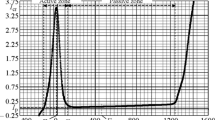Abstract
To increase the crack resistance of tire materials in hydrogen media, one adds admixtures of lanthanum (up to 0.05 vol. %) and cerium (up to 0.1 vol. %) to nitrogen-containing 18Mn-4Cr and 18Mn-18Cr steels in the process of experimental melting to refine, modify, and alloy these steels. These admixtures have a positive effect on the amount, form, and uniformity of the distribution of nonmetallic inclusions, qualitatively improve the state of the metal, and change its dislocation structure. The application of calcium (up to 0.05 vol. %) for deoxidation of steel leads to a considerable change in the form and composition of nonmetallic inclusions revealed in the investigation of the fracture surface of specimens. Experimental steels with a high content of chromium, copper, and other alloying elements demonstrate an increase in a resistance to corrosion-mechanical fracture and in long-term strength in a hydrogen medium.
Similar content being viewed by others
REFERENCES
O. P. Ostash, Development of Methods for Estimation and Enhancement of the Low-Temperature Cyclic Crack Resistance of Structural Steels [in Ukrainian], Author's Abstract of the Doctoral-Degree Thesis (Technical Science, 05.02.01, 01.02.04), L'viv (1993).
O. P. Ostash, S. Ya. Yarema, K. A. Yushchenko, V. I. Belotserkovets, V. T. Zmur-Klimenko, and A. N. Vashchenko, “Influence of the structure of 03Kh13AG19 steel on the development of fatigue cracks at normal and low temperatures,” Fiz.-Khim. Mekh. Mater., 13, No. 6, 56–61 (1977).
O. P. Ostash, V. T. Zmur-Klimenko, S. Ya. Yarema, K. A. Yushchenko, L. P. Strok, and V. I. Belotserkovets, “Low-temperature cyclic crack resistance of welded joints of Fe-Cr-Ni and Fe-Cr-Mn steels,” Fiz.-Khim. Mekh. Mater., 19, No. 3, 39–43 (1983).
O. P. Ostash, V. T. Zmur-Klimenko, S. Ya. Yarema, K. A. Yushchenko, L. P. Strok, and V. I. Belotserkovets, “Influence of a low temperature on the rate and microfractographic specific features of the development of fatigue cracks in 07Kh13G20AN4 steel,” Fiz.-Khim. Mekh. Mater., 17, No. 2, 112–114 (1981).
O. P. Ostash, V. T. Zmur-Klimenko, and L. P. Strok, “Influence of strain-induced martensite on low-temperature cyclic crack resistance of a welded joint of 03Kh13AG19 steel,” Fiz.-Khim. Mekh. Mater., 19, No. 2, 49–55 (1983).
O. M. Romaniv, S. Ya. Yarema, H. M. Nykyforchyn, et al., “Fatigue and cyclic crack resistance of structural materials,” in: V. V. Panasyuk (editor), Fracture Mechanics and Strength of Structures [in Russian], Vol. 4, Naukova Dumka, Kiev (1990).
O. M. Romaniv and H. M. Nykyforchyn, Mechanics of Corrosion Fracture of Structural Alloys [in Russian], Metallurgiya, Moscow (1986).
O. I. Balyts'kyi, Modern Materials for Powerful Turbogenerators [in Ukrainian], Karpenko Physicomechanical Institute, Ukrainian Academy of Sciences, L'viv (1999).
O. I. Balyts'kyi, V. I. Pokhmurs'kyi, V. H. Makarenko, and I. A. Povyshev, Corrosion-Resistant Nonmagnetic Steel [in Russian], Inventor's Certificate No. 4313845/31–02, Announced 06.10.87, Published 23.06.89, Bulletin No. 23.
O. I. Balyts'kyi, V. I. Pokhmurs'kyi, I. A. Povyshev, and V. H. Makarenko, Nonmagnetic Steel [in Russian], Inventor's Certificate No. 4371563/31–02, Announced 02.12.87, Published 23.06.89, Bulletin No. 23.
Author information
Authors and Affiliations
Rights and permissions
About this article
Cite this article
Balyts'kyi, O.I. Effect of Hydrogen on Structural Strength of High-Nitrogen Chromium–Manganese Steels. Materials Science 36, 541–545 (2000). https://doi.org/10.1023/A:1011362005213
Issue Date:
DOI: https://doi.org/10.1023/A:1011362005213




